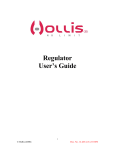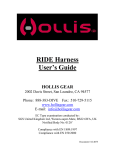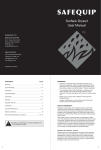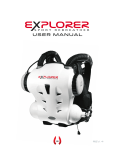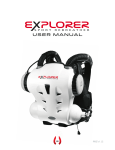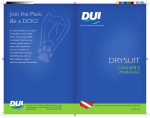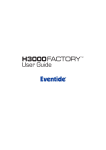Download biodry drysuit USER GUIDE
Transcript
biodry drysuit USER GUIDE © Hollis (2014) Doc. 12-4044-r02 (9/12/14) biodry drysuit USER GUIDE Contents NOTICES......................................................................................................................................3 WARNINGS..................................................................................................................................4 DRYSUIT LIMITED WARRANTY PROGRAM.............................................................................5 INTRODUCTION..........................................................................................................................6 GUIDELINES................................................................................................................................7 DIAGRAM....................................................................................................................................8 NECK AND WRIST SEALS.........................................................................................................9 FEATURES................................................................................................................................10 PRE-DIVE PREPARATION........................................................................................................11 DONNING THE DRYSUIT..........................................................................................................12 OPERATION AND USE.............................................................................................................13 DOFFING THE DRYSUIT..........................................................................................................14 CARE AND MAINTENANCE.....................................................................................................15 TROUBLESHOOTING...............................................................................................................16 RECORDS..................................................................................................................................17 INSPECTIONS AND SERVICE..................................................................................................17 NOTES.......................................................................................................................................17 DANGERS, WARNINGS, CAUTIONS, AND NOTES Pay attention to the following symbols when they appear throughout this document. They denote important information and tips. ! D ANGERS: are indicators of important information that if ignored would lead to severe injury or death. ! W ARNINGS: are indicators of important information that if ignored could lead to severe injury or death. ! CAUTIONS: are indicators of information that if ignored may lead to minor to moderate injury. ! N OTES: indicate tips and advice that can inform of features, aid assembly, or prevent damage to the product. © Hollis (2014) 2 Doc. 12-4044-r02 (9/12/14) biodry drysuit USER GUIDE Notices COPYRIGHT NOTICE This operating manual is copyrighted, all rights are reserved. It may not, in whole or in part, be copied, photocopied, reproduced, translated, or reduced to any electronic medium or machine readable form without prior consent in writing from Hollis. BioDry Drysuit User Guide, Doc. No. 12-4044 © Hollis, 2014 San Leandro, CA USA 94577 (510)729-5110 TRADEMARK, TRADE NAME, AND SERVICE MARK NOTICE Hollis, the Hollis logo, BioDry, and BioFlex are registered trademarks of Hollis. All rights are reserved. Wearforce® is a registered trademark of Xymid. PATENT NOTICE U.S. Patents have been issued, or applied for, to protect the following design features: BioFlex (U.S. Patent No. 5,403,123 and EURO Patent No. 0581524A1), and Gas Impermeable Laminate (U.S. Patent No. 5,693,412). © Hollis (2014) 3 Doc. 12-4044-r02 (9/12/14) biodry drysuit USER GUIDE ! Warnings ! • DO NOT use the BioDry drysuit unless, or until, you have received proper training in drysuit diving and have thoroughly practiced all skills, including emergency skills, in a controlled environment, while under the direct supervision of a diving instructor certified by an industry recognized training agency to instruct divers in the proper use of drysuits. • The content of this user’s guide is not intended as “diver training” material, or as a substitute for the specialized training required for diving with a drysuit. • Read and understand this user’s guide thoroughly before using the BioDry drysuit. • Always use a buoyancy compensator device (used in the manner you were/will be trained in a proper drysuit course) when diving with your drysuit. • Always wear an appropriate amount of insulation for the environment and workload of the planned dive. • Always weight yourself properly according to your drysuit training. • Inspect valves, zippers, and seals for proper operation before each dive and have your suit serviced regularly by a qualified technician at a Hollis authorized dealer. • Insure dive buddies understand the operation of your drysuit. • Diving in very cold waters at and below 40° F (5° C) requires specialized training and equipment suitable for those temperatures. An appropriate course in ice diving or a similar course from a recognized training agency is a necessary prerequisite for such dives. • Diving in contaminated or radioactive waters is hazardous to your health. Contaminated environments require specialized procedures, equipment, and training. Hollis drysuits do not guarantee protection from contaminated or radioactive waters. • Using a drysuit or buoyancy compensator as a lift bag is a dangerous practice that must be avoided. Uncontrolled rapid ascents leading to decompression sickness or arterial gas embolism could be the result of such activity. • DO NOT wear over-boots or fins that are too tight or circulation could be impeded in the foot, leading to cold cramping feet. © Hollis (2014) 4 Doc. 12-4044-r02 (9/12/14) biodry drysuit USER GUIDE Drysuit Limited Warranty Program The specified Limited Warranty program described below applies only to Drysuits and related products. This warranty is composed of four sections: SEC. 1 WORKMANSHIP SEC. 2 MATERIAL SEC. 3 ZIPPERS AND VALVES SEC. 4 SEALS SEC. 1 - WORKMANSHIP (FIVE (5) YEAR WARRANTY) Hollis guarantees, to the original purchaser, that Hollis drysuits (except for the neck, wrist seals, zipper, and valves) will be free from defects in workmanship for a period of five (5) years, from the date of purchase from an authorized Hollis dealer. SEC. 2 – MATERIAL (ONE (1) YEAR LIMITED WARRANTY) Hollis guarantees, to the original purchaser, that Hollis patented Wearforce material will be free from defects for a period of one (1) year from the original date of purchase from an authorized Hollis dealer. SEC. 3 – ZIPPERS AND VALVES (ONE (1) YEAR LIMITED WARRANTY) Hollis guarantees, to the original purchaser, that the Zipper, Inflation Valve, and Deflation Valve will be free from defects in material and workmanship for a period of one (1) year from the original date of purchase from an authorized Hollis Dealer. SEC. 4 – NECK AND WRIST SEALS (NINETY (90) DAY WARRANTY) Hollis guarantees, to the original purchaser, that the Neck and Wrist Seals will be free from defects in material and workmanship for a period of ninety (90) days from the original date of purchase from an authorized Hollis Dealer or until cut/trimmed for fitting. Any products (Drysuits or related products) determined by Hollis to be defective in material or workmanship in accordance with the above warranties will be repaired or replaced at the sole discretion of Hollis. This shall be free of charge when received at the factory freight prepaid together with the original proof of purchase. This warranty does not cover, and Hollis shall not be liable for incidental or consequential damages. This warranty does not cover any damages resulting from misuse, abuse, neglect, alteration (including trimming of seals), failure to perform proper maintenance as instructed, damage caused by contaminants, or unauthorized repair/service. This warranty does not cover any representation or warranty made by dealers beyond the provisions of this warranty. This warranty does not cover costs incurred for normal repair, inspection, and preventative maintenance. This warranty is a consumer warranty extended only to the original retail purchaser, and does not apply to drysuits and related products used for commercial purposes. You must establish proof of purchase to obtain warranty service or replacement. Proof of purchase may be established by completing the warranty registration online at the “Product Registration” section of our website www.hollis.com/registerproduct. This warranty gives you specific legal rights, and you may also have other rights which vary from state to state. Some states do not allow the exclusion or limitation of implied warranties so the above limitations and exclusions may not apply to you. © Hollis (2014) 5 Doc. 12-4044-r02 (9/12/14) biodry drysuit USER GUIDE Introduction This user’s guide describes the unique functions and features of the Hollis BioDry drysuit. The more acquainted that you become with your new BioDry drysuit, the more you will enjoy your diving experience. By following the instructions in this guide, you will understand how your Hollis BioDry drysuit system works, how to make best use of its features and how to ensure it is set up best for your needs. All Hollis products are constructed with the highest quality materials and utilize the latest computer aided design and manufacturing techniques to ensure their highest performance and reliability. Statement of Limitation: In consideration of the sale of the BioDry suit to you, you agree and understand that in no event will, Hollis, its distributors or retailers, be held liable for any personal injuries resulting from its operation, or for any other damages whether direct, indirect, incidental, or consequential even if Hollis is advised of such damages. Some states do not allow the exclusion or limitation of implied liabilities for incidental or consequential damages, so the above statement may not apply to you. © Hollis (2014) 6 Doc. 12-4044-r02 (9/12/14) biodry drysuit USER GUIDE Guidelines Hollis along with other manufacturers of drysuits have adopted and endorsed the following guidelines: • Complete a drysuit diving course from a qualified instructor and stay current. • Use a BCD (Buoyancy Compensator Device) for surface floatation and backup. • Practice your drysuit skills under controlled conditions until they become second nature. • Dive with a buddy who understands your drysuit system. • Use the correct amount of insulation for the water temperature in which you are diving and your exercise rate. • Do not weight yourself heavier than neutral buoyancy with an empty tank. Your weight should allow you to make a safety stop at 15 feet (5 meters) upon completion of your dive with 500 psi (40 BAR) or less gas in your tank. • Check your valves, zippers and seals before each dive. • Perform preventative maintenance and repairs on your suit and valves regularly, and have them serviced by an authorized Hollis drysuit technician annually. If the condition of your suit is ever in question, have it serviced sooner. • Know your limitations and DO NOT exceed them. © Hollis (2014) 7 Doc. 12-4044-r02 (9/12/14) biodry drysuit USER GUIDE Diagram 1 2 3 4 5 6 7 8 © Hollis (2014) 1. NECK SEAL 2. POWER INFLATOR 3. ADJUSTABLE DUMP VALVE 4. ZIPPER 5. WRIST SEAL 6. THIGH POCKET 7. KNEE PAD 8. OVER-BOOT 8 Doc. 12-4044-r02 (9/12/14) biodry drysuit USER GUIDE Neck and Wrist Seals The BioDry drysuit has been fitted with latex seals that may need to be trimmed to enlarge the openings to fit correctly. If you are new to wearing a drysuit with latex seals, it may seem uncomfortable when initially worn, but latex seals should fit snugly. Before diving, test the seals by wearing them for a few minutes to determine the “comfort” factor. Latex should not be too tight. If they cause numbing, tingling, loss of blood flow, or restrict breathing; they need to be trimmed for a larger opening. ! CAUTIONS: Over-trimming of a seal is an easy mistake for someone new to drysuits to make. When trimming the seals be sure to only trim the minimum amount and retest the “comfort” factor before trimming more. Once a seal has been trimmed larger it cannot be made smaller. If you proceed with caution and follow the “Trimming a Seal” steps below you should be able to get a seal sized properly. But if there is any question about the fit, consult your local authorized Hollis dealer for further guidance (to prevent the delays and expense of replacing an otherwise good seal). ! NOTE: Trimming of a seal is a modification of the product and does not constitute a manufacturer’s defect. As such if a seal leaks due to over trimming it is not covered under the manufacturer’s warranty. If you are unfamiliar with sizing a latex seal properly, Hollis strongly recommends you seek the assistance of an authorized Hollis drysuit technician. If that is not possible proceed with the directions below on trimming latex seals. TRIMMING A SEAL • Use long / sharp scissors to make clean cuts. • Cut evenly just above the molding rings (* in image below). • Use one continuous cut to avoid leaving any jagged edges that could cause a Seal to split or tear. • Only cut one ring from the seal at a time, trying it on after each cut. Take into account that the weight of the suit on the neck seal while worn will affect the feel and fit of the neck seal. • REMEMBER material once removed can not be replaced. Proceed in these steps until the correct fit is achieved. ! NOTE: Some divers have an indentation that is formed when flexing the wrist. This indentation may cause a gap in the seal allowing the slight entry of water when the wrist is flexed. Trying to prevent extreme flexing of the wrist may alleviate water entry. A little water will not cause any harm and is no need for alarm. But individuals who have very pronounced tendons may consider using a dry glove system to increase comfort. ! WARNING: Extremely tight seals can restrict flow of blood, possibly causing serious injury or death. © Hollis (2014) 9 Doc. 12-4044-r02 (9/12/14) biodry drysuit USER GUIDE Features SUSPENDERS Each suit comes with adjustable suspenders to allow you to wear the suit with the upper half off while on the surface between dives. This can help keep you from getting over-heated. The suspenders will keep the leg portion pulled up; so you can walk freely. It is a good idea to wrap the sleeves around your waist to keep the seals from dragging on the ground while wearing the suit in this manner. KNEE PADS Wearforce® is tough stuff; so we decided to use a second layer over the high wear area of the knees. This has the additional benefit of maintaining the stretch and flexibility characteristics of the suit without sacrificing durability. DRY ZIPPER The BioDry drysuit dry zipper allows for donning and doffing the suit, and when fully and properly closed, provides a watertight seal. There have been two versions, metal or plastic teeth zippers, sold by Hollis. The dry zipper is a very important part of the suit and must be treated with care. Misuse of the dry zipper may result in permanent damage and necessary replacement (see “Care and Maintenance” section). For additional protection of the dry zipper, a protective over-zipper is provided, and it should always be closed when the Dry Zipper is closed. THIGH POCKETS The FX 100 and BX 200 both come standard with thigh pockets on both right and left legs. The pockets come equipped with a stainless steel D-ring (item 1) and grommets (item 2) on the sides for mounting a piece of shock-cord or line that is knotted on both ends. This is so you can clip off accessories with a bolt snap for easy location (in low light) revomal, and organization of items. The thigh pockets also have grommets (item 4) in the bottom to drain water and Velcro strips (item 3) to streamline the pocket bellows when the pocket is empty. COLD WATER COLLAR (OPTIONAL) The warm water collar insulates and minimizes water movement around the neck. The bib of the hood should be tucked under the warm water collar. © Hollis (2014) 10 Doc. 12-4044-r02 (9/12/14) biodry drysuit USER GUIDE PRE-Dive Preparation BEFORE DONNING YOUR DRYSUIT • Check the latex neck and wrist seals for nicks, cracking or any sign of deterioration. Also, that they are not sticky (due to exposure to excessive heat or chemicals) • Lubricate the Neck and Wrist Seals with either pure talcum powder or a mild solution of soap or shampoo (5 parts water to 1 part soap). ! CAUTION: DO NOT use scented talcum powder. The oils may cause damage to the latex Seals. • Check that the teeth of the zipper are clear of any debris and that the zipper operates smoothly. DO NOT use excess force when opening and closing it. ! N OTE: The plastic teeth dry zipper does not require routine lubrication. • To lubricate the metal teeth version zipper, close it and apply commercially available beeswax or zipper wax to the outside of the teeth only. ! CAUTION: NEVER use aerosol lubricants. They may cause damage to the fabric of the suit. • Inspect the entire suit for any cuts, tears or other damage that would affect the integrity of the suit. • Check inflator valve operation by connecting a LP inflator hose to the quick disconnect fitting and depressing the button on the valve. ! NOTE: The included LP inflator hose must be installed to the first stage supply regulator according to its instructions. • Check the adjustable dump valve to make sure it holds and vents air properly. ! C AUTION: DO NOT continue inflation if the valve displays any indication of being stuck in the closed position, unable to relieve pressure. © Hollis (2014) 11 Doc. 12-4044-r02 (9/12/14) biodry drysuit USER GUIDE Donning the Drysuit The BioDry suit has little inherent insulation. Thermal protection undergarments should be worn in an amount that will keep you comfortable throughout the dive. In addition to water temperature and duration of the dive, your physical condition and anticipated activity rate should be taken into consideration to avoid thermal hazards. ! C AUTION: To help avoid overheating prior to water entry, Hollis recommends preparing and setting up all of your equipment prior to putting on your thermal wear and BioDry drysuit. • Remove any items such as rings, watches, earrings and other jewelry that could damage the latex seals. • Don undergarments appropriate for temperature conditions. • Ensure undergarments fit comfortably and are sized correctly. • Open the zipper completely and hold the suit open. Use care not to get sand and debris in the zipper. • While sitting down, put your feet into the suit. Nylon shelled undergarments and socks will ease donning of the suit. • As you stand up, ease the suit up your legs ensuring there is no slack material along the length of each leg. • Pull the suit snugly up the full length of your inseam. • If your suit is equipped with socks, put over-boots on by sliding the foot into the over-boot as far as possible, tightening, and tie the cord laces. Ensure they are not too tight. This may cause cramping and loss of blood flow to the foot. • Put one arm through the sleeve of the suit and ease your hand through the wrist seals. DO NOT tug on the sleeve. Instead, work the seal over your hand using fingers from your other hand between the seal and your skin. Stretch the seal opening just big enough to fit your hand through. DO NOT put pressure on the seal with your finger nails or put unneeded stress on the seals. Repeat for the other arm. • Adjust the wrist seals so they lay flat against your wrist in a comfortable position. • Pull the suit up your torso as much as possible. • Insert both hands into the top opening of the neck seal and simultaneously spread the opening as you pull the seal down over your head. Avoid putting pressure on the seal with your fingernails. • Adjust the neck seal so it lays flat against your neck in a comfortable position low on your neck. DO NOT turn the top edge of the seal inward. • To close the zipper, use a steady even pull, making sure there is nothing obstructing the zippers teeth. DO NOT force the zipper if it gets stuck, undo and retry. For rear entry suits have your buddy close the zipper for you. • Make sure the zipper is firmly in the closed position, and then close the outer zipper to protect the dry zipper. • Vent any excess air from the suit by inserting two fingers of each hand between the neck seal and your neck and crouching down. • After donning your scuba assembly, route the drysuits LP inflator hose under your arm and connect the quick disconnect coupling to the power inflator valve located on your chest. • Test the operation of the power inflator valve by pressing the Inflator button, allowing air flow from the tank into the suit. • Turn the adjustable dump valve to ensure it adjusts without restriction, and then test the unit by depressing the valve and venting air from the suit. © Hollis (2014) 12 Doc. 12-4044-r02 (9/12/14) biodry drysuit USER GUIDE Operation and use ! WARNING: Full operation and use of a drysuit is beyond the scope of this manual and requires proper training from a qualified drysuit instructor. The text below only covers basic suit function. ! WARNING: Your BCD should be used for surface flotation. On the surface, your drysuit should only be used for backup floatation in the event of an emergency. Always wear a BCD with the BioDry drysuit. • Prior to water entry, vent all air from the suit and ensure you are properly weighted. This will ensure a safe entry with a natural attitude in the water. • With no air in the suit it will tend to cling to your body. However, once you are underwater you will inflate the suit (according to the method you are taught by your drysuit Instructor) to remove this “suit squeeze” effect. ! WARNING: As your depth decreases during a multi level dive, or during your ascent to the surface, the air in the BioDry suit will expand creating positive buoyancy this must be controlled. POWER INFLATOR / ADJUSTABLE DUMP VALVE The Hollis BioDry drysuit is equipped with a low pressure power inflator located in the center of the chest. The inflator valve swivels 360 degrees which allows for routing of the LP inflator hose under either arm. To safely dump air from the BioDry drysuit, there is a one way dump valve that is located on the left shoulder. This dump valve can be set in both an open (automatic) and closed (manual, turned fully clockwise) position to help control the amount of air needed to maintain comfort and desired buoyancy. INFLATING THE DRYSUIT • Attach the threaded end of the LP inflator hose to your regulator’s first stage and pressurize. • Attach the coupling side of the LP hose to the drysuit power inflator. The suit’s power inflator rotates 360 degrees which allows routing of the hose under either arm. • Lightly press the center button of the drysuit power inflator, using small bursts (to reduce the chance of freezing or over-inflation) of air to inflate the drysuit. • The drysuit will only hold air if the zippers, neck and wrist seals and dump valve are securely sealed. ADJUSTABLE DUMP VALVE CONTROL AND DUMPING AIR • Turning the dump valve counter clockwise until it stops will open the valve allowing air to escape the drysuit freely. • Turning the dump valve clockwise until it stops will close the valve and will NOT allow air to escape the drysuit. • Pushing down on the dump valve will vent air with the valve adjusted to any position. • Air will pool at the highest point of the drysuit. When dumping air in the water, make sure that the dump valve is at the highest point of the suit and closest to the surface to allow the air to escape easily. • To check the dump valve, close the zipper completely and block the neck and wrist seals with smooth cylindrical containers. Close the adjustable dump valve by turning it clockwise until it stops. Inflate the suit and check to make sure there are no leaks in the dump valve. Then turn the valve counter clockwise to make sure the valve vents air properly through the valve. © Hollis (2014) 13 Doc. 12-4044-r02 (9/12/14) biodry drysuit USER GUIDE doffing the drysuit • Disconnect the LP inflator hose from the power inflator on your drysuit and remove your scuba assembly. • Remove all accessory equipment, such as a weight belt, ankle weights, hood, gloves, etc. • Rinse any sand or debris off the BioDry suit, paying particular attention to the zipper area. • Unzip the suit using a steady even pull, making sure to open it completely. • Insert both hands into the top opening of the neck seal, and simultaneously spread the opening as you pull your head down and lifting the neck seal over your head. Avoid putting pressure on the seal with your fingernails. • To remove the wrist seals, insert two fingers between the seal and your wrist of your opposite hand and pull your hand out of the seal opening. Avoid putting pressure on the seal with your fingernails. • Lift your arm up and out of the sleeve. • Repeat for the other arm. • Remove over-boots by untying and loosening the cord laces. • Using care not to get sand or debris on the zipper and seals, slide the suit down until it is below your crotch, then sit down to remove your legs and feet. ! CAUTION: Ensure that you do not drag or sit on your wrist and neck seal while removing the suit. © Hollis (2014) 14 Doc. 12-4044-r02 (9/12/14) biodry drysuit USER GUIDE Care and Maintenance CLEANING AND STORAGE • After your dive, thoroughly rinse the outside of the suit and flush the power inflator and adjustable dump valve with running fresh water. • Carefully sponge the neck and wrist seals with a mild solution of soapy water and rinse thoroughly. ! C AUTION: Any contamination due to petroleum products, paraffin or other solvents may affect the latex seals or the butyl membrane of the suit and must be washed off immediately. • Ensure the zipper is clean and free of sand and debris. If necessary, clean with a toothbrush and a mild solution of soapy water. ! NOTE: The plastic teeth dry zipper does not require routine lubrication. • Close the zipper and lubricate the outside of the teeth with beeswax or zipper wax. • After rinsing, blow the power Inflator and adjustable dump valve dry with low pressure air and hang the suit on a wide hanger to dry naturally with the zipper open. ! CAUTION: DO NOT use heat to dry the suit or hang the suit in direct sunlight. • Once the suit is thoroughly dry inside and out, dust the neck and wrist seals with unscented talcum powder. • Store the suit by hanging it with the zipper open on a wide hanger, in a cool dry location away from electric motors or any other ozone producing device that can adversely affect the latex seals. • If folding the suit for storage, ensure that the zipper is open and will be on the outside and protected from damage and contamination. ! CAUTION: DO NOT set anything heavy on the zipper or damage may result. ! WARNING: DO NOT disassemble or attempt to repair the power inflator or adjustable dump valve. Doing so could cause them to malfunction, resulting in serious injury or death. It will also void the warranty. REPAIRS AND SERVICE • In the event that your BioDry drysuit requires any form of repair or service, return it to your authorized Hollis dealer who will arrange for the appropriate repair. • For warranty repair, provide the authorized Hollis dealer with a copy of the original sales receipt and your copy of the warranty registration. ! C AUTION: Attempts to make temporary repairs in the field that alter the suit may void the limited warranty. Inspection and service of the suit and valves should be conducted annually by an authorized Hollis technician. Costs of annual inspection and service are not covered by the limited warranty. © Hollis (2014) 15 Doc. 12-4044-r02 (9/12/14) biodry drysuit USER GUIDE Troubleshooting LEAK IN SUIT • Check the dry zipper is completely closed and there are not obstructions in the zipper. • Check the latex seals are properly seated around the neck and wrist and that they are flush against the skin. Make sure there are no obstructions in the seals. Ensure that that the seals have not been over-trimmed and that they fit properly (If there is any question, have your Hollis dealer or drysuit course instructor assist you with evaluating this.) • Check adjustable dump valve for any dirt or debris that would prevent it from working properly. Flush with fresh water to clear. • Check for any punctures or tears in the drysuit material and seals. ! NOTE: If the location of the leak cannot be determined and the suit continues to leak, a leak test should be performed by your authorized Hollis dealer. POWER INFLATOR AND ADJUSTABLE DUMP VALVE ! WARNING: If the power inflator and adjustable dump valve are leaking or not working properly and the problem is not solved by the steps described in the “Care and Maintenance” section, DO NOT disassemble or attempt to repair the power inflator or adjustable dump valve. Doing so could cause them to malfunction, resulting in serious injury or death. It will also void the warranty. © Hollis (2014) 16 Doc. 12-4044-r02 (9/12/14) biodry drysuit USER GUIDE Records MODEL: SERIAL NUMBER: DATE OF PURCHASE: HOLLIS DEALER: DEALER PHONE NUMBER: Inspections and service DATE SERVICE PERFORMED DEALER/TECHNICIAN Notes San Leandro, CA USA 94577 (510)729-5110 www.hollisgear.com e-mail: [email protected] © Hollis (2014) 17 Doc. 12-4044-r02 (9/12/14)



















